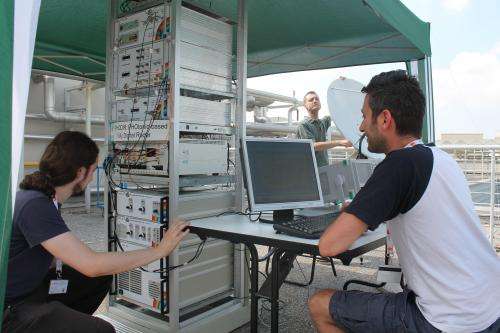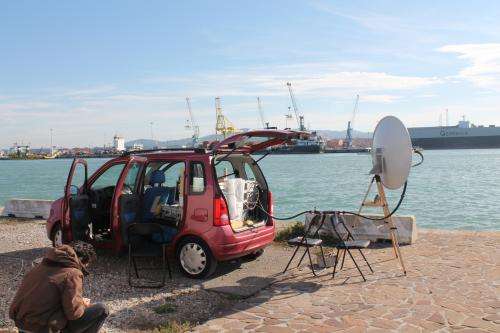March 20, 2014 report
Researchers develop fully photonics-based radar system (Update)

(Phys.org) —A team of researchers in Italy has developed the first fully photonics-based coherent radar system. In their paper published in the journal Nature, the team describes how they built their new radar system and what it might mean for the future of radar systems. Jason McKinney of the US Naval Research Laboratory offers a News & Views perspective piece on the development of the radar system in the same issue and outlines issues involved with attempting to implement such a system into real world applications.
The radar system, part of a project known as PHODIR (Photonics-based fully digital radar) is an effort to improve the tracking and speed calculation abilities of current electronic signal based systems. It's well understood that making improvements in such a system will require higher frequency signals, something that can't be done with current systems due to an increase in noise that creates more uncertainty in the signals received. For that reason, scientists have been looking to use lasers—such signals are much more stable.
Building a radar system using a laser requires an optical mode of oscillation that is able to maintain a highly stable phase relationship—that's the hurdle the researchers had to overcome. They used a mode-locked laser, it allowed for establishing a periodic sequence of laser pulses that exhibited low timing jitter. Using it, in conjunction with a computer running software they wrote, they were able to produce an RF signal with low phase noise by adding an optical filter located past the laser, which was sent to a photo diode, allowing for two optical modes to be selected.

The radar system the team built is still just a prototype, though it does appear feasible. The team tested its abilities by monitoring real aircraft taking off at a nearby airport and then comparing what they observed with data from traditional electronic signal based systems. They report that the systems matched very closely. That of course is just an initial test, as McKinney notes, much more research and testing will need to be done before the researchers will know if such a system could provide better results than conventional systems. Also, another area of concern is range, which could impact jitter, and thus the accuracy of the system.
More information: A fully photonics-based coherent radar system, Nature 507, 341–345 (20 March 2014) DOI: 10.1038/nature13078
Abstract
The next generation of radar (radio detection and ranging) systems needs to be based on software-defined radio to adapt to variable environments, with higher carrier frequencies for smaller antennas and broadened bandwidth for increased resolution. Today's digital microwave components (synthesizers and analogue-to-digital converters) suffer from limited bandwidth with high noise at increasing frequencies, so that fully digital radar systems can work up to only a few gigahertz, and noisy analogue up- and downconversions are necessary for higher frequencies. In contrast, photonics provide high precision and ultrawide bandwidth, allowing both the flexible generation of extremely stable radio-frequency signals with arbitrary waveforms up to millimetre waves, and the detection of such signals and their precise direct digitization without downconversion. Until now, the photonics-based generation and detection of radio-frequency signals have been studied separately and have not been tested in a radar system. Here we present the development and the field trial results of a fully photonics-based coherent radar demonstrator carried out within the project PHODIR27. The proposed architecture exploits a single pulsed laser for generating tunable radar signals and receiving their echoes, avoiding radio-frequency up- and downconversion and guaranteeing both the software-defined approach and high resolution. Its performance exceeds state-of-the-art electronics at carrier frequencies above two gigahertz, and the detection of non-cooperating aeroplanes confirms the effectiveness and expected precision of the system.
Journal information: Nature
© 2014 Phys.org




















